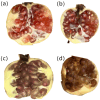Non-Destructive Detection of Pomegranate Blackheart Disease via Near-Infrared Spectroscopy and Soft X-ray Imaging Systems
- PMID: 40724275
- PMCID: PMC12294369
- DOI: 10.3390/foods14142454
Non-Destructive Detection of Pomegranate Blackheart Disease via Near-Infrared Spectroscopy and Soft X-ray Imaging Systems
Abstract
Pomegranate blackheart disease, as an internal disease affecting the global pomegranate industry, is difficult to identify externally and urgently requires non-destructive detection methods for rapid diagnosis. This study established discriminative models for blackheart disease severity in pomegranates by using near-infrared (NIR) spectroscopy and soft X-ray imaging techniques. The results showed that the optimal NIR-based discriminative model, constructed with a Random Forest (RF) algorithm based on spectra preprocessed by the second-derivative (D2) denoising and a Competitive Adaptive Reweighted Sampling (CARS) algorithm, achieved a prediction set accuracy of 86.00%; the optimal soft X-ray imaging-based discriminative model, built with an RF algorithm using textural features extracted from images preprocessed by median filtering and a Contrast-Limited Adaptive Histogram Equalization (CLAHE) algorithm combined with gray-level co-occurrence matrix (GLCM) and gray-gradient co-occurrence matrix (GGCM) algorithms, reached a prediction set accuracy of 93.10%. In terms of model performance, the model based on soft X-ray imaging exhibited superior performance. Both techniques possess distinct advantages and limitations yet enable non-destructive detection of pomegranate blackheart disease. Further technical optimizations in the future could provide enhanced support for the healthy development of the pomegranate industry.
Keywords: blackheart disease; food non-destructive detection; near-infrared spectroscopy; pomegranate; soft X-ray.
Conflict of interest statement
The authors declare no conflicts of interest.
Figures














Similar articles
-
Artificial intelligence for diagnosing exudative age-related macular degeneration.Cochrane Database Syst Rev. 2024 Oct 17;10(10):CD015522. doi: 10.1002/14651858.CD015522.pub2. Cochrane Database Syst Rev. 2024. PMID: 39417312
-
Contrast-enhanced ultrasound using SonoVue® (sulphur hexafluoride microbubbles) compared with contrast-enhanced computed tomography and contrast-enhanced magnetic resonance imaging for the characterisation of focal liver lesions and detection of liver metastases: a systematic review and cost-effectiveness analysis.Health Technol Assess. 2013 Apr;17(16):1-243. doi: 10.3310/hta17160. Health Technol Assess. 2013. PMID: 23611316 Free PMC article.
-
Signs and symptoms to determine if a patient presenting in primary care or hospital outpatient settings has COVID-19.Cochrane Database Syst Rev. 2022 May 20;5(5):CD013665. doi: 10.1002/14651858.CD013665.pub3. Cochrane Database Syst Rev. 2022. PMID: 35593186 Free PMC article.
-
Comparison of Two Modern Survival Prediction Tools, SORG-MLA and METSSS, in Patients With Symptomatic Long-bone Metastases Who Underwent Local Treatment With Surgery Followed by Radiotherapy and With Radiotherapy Alone.Clin Orthop Relat Res. 2024 Dec 1;482(12):2193-2208. doi: 10.1097/CORR.0000000000003185. Epub 2024 Jul 23. Clin Orthop Relat Res. 2024. PMID: 39051924
-
Rapid Determination of Polysaccharides in Cistanche Tubulosa Using Near-Infrared Spectroscopy Combined with Machine Learning.J AOAC Int. 2023 Jul 17;106(4):1118-1125. doi: 10.1093/jaoacint/qsac144. J AOAC Int. 2023. PMID: 36355447
References
-
- Kahramanoglu I., Usanmaz S., Nizam I. Incidence of heart rot at pomegranate fruits caused by Alternaria spp. in Cyprus. Afr. J. Agric. Res. 2014;9:905–907.
-
- Tziros G.T., Lagopodi A.L., Tzavella-Klonari K. Alternaria alternata fruit rot of pomegranate (Punica granatum) in Greece. Plant Pathol. 2008;57:379. doi: 10.1111/j.1365-3059.2007.01668.x. - DOI
-
- Ezra D., Kirshner B., Gat T., Shteinberg D., Kosto I. Heart rot of pomegranate, when and how does the pathogen cause the disease? Acta Hortic. 2015;1089:167–171. doi: 10.17660/ActaHortic.2015.1089.19. - DOI
-
- Perelló A., Moreno M., Sisterna M., Tziros G.T., Lagopodi A.L., Tzavella-Klonari K. Alternaria infectoria species-group associated with black point of wheat in Argentina. Plant Pathol. 2008;57:379. doi: 10.1111/j.1365-3059.2007.01713.x. - DOI
-
- Jaeger S.R., Antúnez L., Ares G., Johnston J.W., Hall M., Harker F.R. Consumers’ visual attention to fruit defects and disorders: A case study with apple images. Postharvest Biol. Technol. 2016;116:36–44. doi: 10.1016/j.postharvbio.2015.12.015. - DOI
Grants and funding
LinkOut - more resources
Full Text Sources
Miscellaneous

